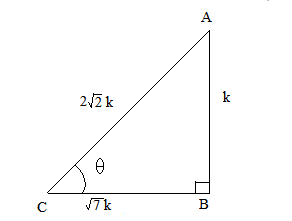If $\tan \theta=\frac{1}{\sqrt{7}}$ then prove that $\left(\frac{\operatorname{cosec}^{2} \theta+\sec ^{2} \theta}{\operatorname{cosec}^{2} \theta-\sec ^{2} \theta}\right)=\frac{4}{3}$.
Let us consider a right $\triangle \mathrm{ABC}$, right angled at $\mathrm{B}$ and $\angle C=\theta$.
Now it is given that $\tan \theta=\frac{A B}{B C}=\frac{1}{\sqrt{7}}$.

So, if $\mathrm{AB}=k$, then $\mathrm{BC}=\sqrt{7} k$, where $k$ is a positive number.
Using Pythagoras theorem, we have:
$A C^{2}=A B^{2}+B C^{2}$
$\Rightarrow \mathrm{AC}^{2}=(k)^{2}+(\sqrt{7} k)^{2}$
$\Rightarrow \mathrm{AC}^{2}=k^{2}+7 k^{2}$
$\Rightarrow \mathrm{AC}=2 \sqrt{2} k$
Now, finding out the values of the other trigonometric ratios, we have:
$\sin \theta=\frac{A B}{A C}=\frac{k}{2 \sqrt{2} k}=\frac{1}{2 \sqrt{2}}$
$\cos \theta=\frac{B C}{A C}=\frac{\sqrt{7} k}{2 \sqrt{2} k}=\frac{\sqrt{7}}{2 \sqrt{2}}$
$\therefore \operatorname{cosec} \theta=\frac{1}{\sin \theta}=2 \sqrt{2}$ and $\sec \theta=\frac{1}{\cos \theta}=\frac{2 \sqrt{2}}{\sqrt{7}}$
Substituting the values of $\operatorname{cosec} \theta$ and $\sec \theta$ in the given expression, we get:
$\frac{\cos e c^{2} \theta-\sec ^{2} \theta}{\cos e c^{2} \theta+\sec ^{2} \theta}$
$=\frac{(2 \sqrt{2})^{2}-\left(\frac{2 \sqrt{2}}{\sqrt{7}}\right)^{2}}{(2 \sqrt{2})^{2}+\left(\frac{2 \sqrt{2}}{\sqrt{7}}\right)^{2}}$
$=\frac{8-\left(\frac{8}{7}\right)}{8+\left(\frac{8}{7}\right)}$
$=\frac{\frac{56-8}{7}}{\frac{56+8}{7}}$
$=\frac{48}{64}=\frac{3}{4}=\mathrm{RHS}$
i.e., LHS = RHS
Hence proved.
